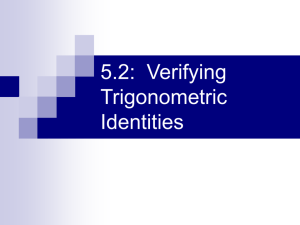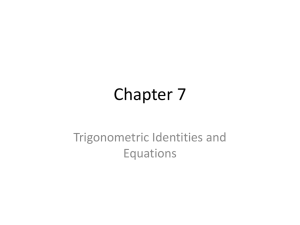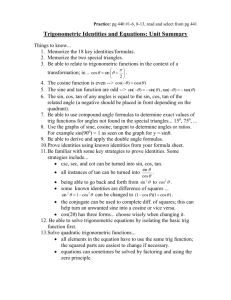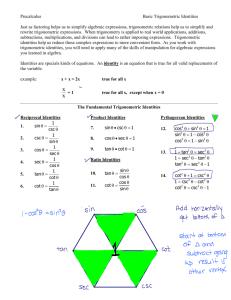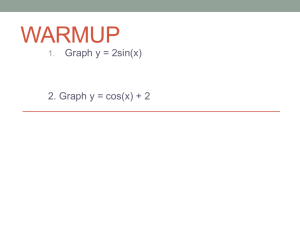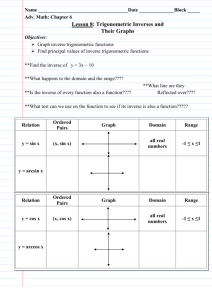Chapter 3 Section 1
advertisement
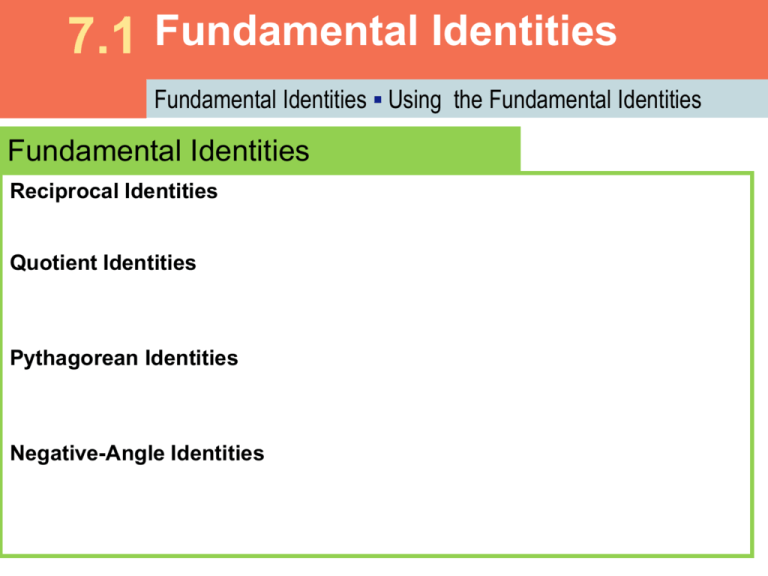
7.1 Fundamental Identities Fundamental Identities ▪ Using the Fundamental Identities Fundamental Identities Reciprocal Identities Quotient Identities Pythagorean Identities Negative-Angle Identities Note In trigonometric identities, θ can be an angle in degrees, an angle in radians, a real number, or a variable. Example 1 If a) sec θ FINDING TRIGONOMETRIC FUNCTION VALUES GIVEN ONE VALUE AND THE QUADRANT and θ is in quadrant II, find each function value. b) sin θ Example 1 c) cot (-θ) FINDING TRIGONOMETRIC FUNCTION VALUES GIVEN ONE VALUE AND THE QUADRANT (continued) Caution To avoid a common error, when taking the square root, be sure to choose the sign based on the quadrant of θ and the function being evaluated. EXPRESSING ONE FUNCITON IN Example 2 TERMS OF ANOTHER Express cos x in terms of tan x. Example 3 REWRITING AN EXPRESSION IN TERMS OF SINE AND COSINE Write tan θ + cot θ in terms of sin θ and cos θ, and then simplify the expression. 7.2 Verifying Trigonometric Identities Verifying Identities by Working With One Side ▪ Verifying Identities by Working With Both Sides Hints for Verifying Identities Learn the fundamental identities. Whenever you see either side of a fundamental identity, the other side should come to mind. Also, be aware of equivalent forms of the fundamental identities. Try to rewrite the more complicated side of the equation so that it is identical to the simpler side. It is sometimes helpful to express all trigonometric functions in the equation in terms of sine and cosine and then simplify the result. Hints for Verifying Identities Usually, any factoring or algebraic operations should be performed. For example, the expression can be factored as Also, the sum/difference of two trig expressions such as can be added or subtracted in the same way as any other rational expression. Hints for Verifying Identities As you select substitutions, keep in mind the side you are not changing, because it represents your goal. For example, to verify the identity find an identity that relates tan x to cos x. Since and the secant function is the best link between the two sides. If an expression contains and denominator by , multiplying both the numerator would give which could be replaced with Similar results for 1 – sin x, 1 + cos x, and 1 – cos x may be useful. Caution Verifying identities is not the same as solving equations. Techniques used in solving equations, such as adding the same terms to both sides, should not be used when working with identities since you are starting with a statement that may not be true. Verifying Identities by Working with One Side To avoid the temptation to use algebraic properties of equations to verify identities, one strategy is to work with only one side and rewrite it to match the other side. ? LHS = RHS Example 1 Verify that VERIFYING AN IDENTITY (WORKING WITH ONE SIDE) is an identity. Example 2 Verify that VERIFYING AN IDENTITY (WORKING WITH ONE SIDE) is an identity. Example 3 Verify that VERIFYING AN IDENTITY (WORKING WITH ONE SIDE) is an identity. Example 4 Verify that VERIFYING AN IDENTITY (WORKING WITH ONE SIDE) is an identity. Verifying Identities by Working with Both Sides If both sides of an identity appear to be equally complex, the identity can be verified by working independently on each side until they are changed into a common third result. Each step, on each side, must be reversible. Example 5 Verify that VERIFYING AN IDENTITY (WORKING WITH BOTH SIDES) is an identity. Example 6 APPLYING A PYTHAGOREAN IDENTITY TO RADIOS Tuners in radios select a radio station by adjusting the frequency. A tuner may contain an inductor L and a capacitor. The energy stored in the inductor at time t is given by and the energy in the capacitor is given by where f is the frequency of the radio station and k is a constant. The total energy in the circuit is given by Show that E is a constant function.* 7.3 Sum and Difference Identities Cosine Sum and Difference Identities ▪ Cofunction Identities ▪ Sine and Tangent Sum and Difference Identities Cosine of a Sum or Difference Example 1 FINDING EXACT COSINE FUNCTION VALUES a) Find the exact value of cos 15. b) Find the exact value of c) Find the exact value of cos 87cos 93 – sin 87sin 93. Cofunction Identities Similar identities can be obtained for a real number domain by replacing 90 with Example 2 USING COFUNCTION IDENTITIES TO FIND θ Find an angle that satisfies each of the following: (a) cot θ = tan 25° Example 2 (b) USING COFUNCTION IDENTITIES TO FIND θ (continued) sin θ = cos (–30°) (c) Note - Because trigonometric (circular) functions are periodic, the solutions in Example 2 are not unique. Only one of infinitely many possiblities are given. Applying the Sum and Difference Identities If one of the angles A or B in the identities for cos(A + B) and cos(A – B) is a quadrantal angle, then the identity allows us to write the expression in terms of a single function of A or B. Example 3 REDUCING cos (A – B) TO A FUNCTION OF A SINGLE VARIABLE Write cos(180° - θ) as a trigonometric function of θ alone. Example X1 Suppose that Find cos(s + t). FINDING cos (s + t) GIVEN INFORMATION ABOUT s AND t and both s and t are in quadrant II. Note - The values of cos s and sin t could also be found by using the Pythagorean identities. Sine of a Sum or Difference Tangent of a Sum or Difference Example 4(a) FINDING EXACT SINE AND TANGENT FUNCTION VALUES Find the exact value of sin 75. Example 4(b) FINDING EXACT SINE AND TANGENT FUNCTION VALUES Find the exact value of Example 4(c) FINDING EXACT SINE AND TANGENT FUNCTION VALUES Find the exact value of Example 5 WRITING FUNCTIONS AS EXPRESSIONS INVOLVING FUNCTIONS OF θ Write each function as an expression involving functions of θ. (a) cos (b) (c) Example 6 FINDING FUNCTION VALUES AND THE QUADRANT OF A + B Suppose that A and B are angles in standard position with Find each of the following. (a) sin(A + B) Example 6 (b) tan(A + B) (c) The quadrant of A + B FINDING FUNCTION VALUES AND THE QUADRANT OF A + B (continued) Example X2 VERIFYING AN IDENTITY USING SUM AND DIFFERENCE IDENTITIES Verify that the equation is an identity. Example 7 APPLYING THE COSINE DIFFERENCE IDENTITY TO VOLTAGE Common household current is called alternating current because the current alternates direction within the wires. The voltage V in a typical 115-volt outlet can be expressed by the function where ω is the angular speed (in radians per second) of the rotating generator at the electrical plant, and t is time measured in seconds. (a) It is essential for electric generators to rotate at precisely 60 cycles per second so household appliances and computers will function properly. Determine ω for these electric generators. Example 7 APPLYING THE COSINE DIFFERENCE IDENTITY TO VOLTAGE (continued) (b) Graph V in the window [0, .05] by [–200, 200]. (c) Determine a value of so that the graph of is the same as the graph of 7.4 Double-Angle and Half-Angle Identities Double-Angle Identities ▪ An Application ▪ Product-to-Sum and Sum-to-Product Identities Double-Angle Identities Example 1 Given FINDING FUNCTION VALUES OF 2θ GIVEN INFORMATION ABOUT θ and sin θ < 0, find sin 2θ, cos 2θ, and tan 2θ. Example 2 FINDING FUNCTION VALUES OF θ GIVEN INFORMATION ABOUT 2θ Find the values of the six trigonometric functions of θ if Example 3 Verify that VERIFYING A DOUBLE-ANGLE IDENTITY is an identity. SIMPLIFYING EXPRESSION DOUBLEANGLE IDENTITIES Simplify each expression. Example 4 DERIVING A MULTIPLE-ANGLE IDENTITY Write sin 3x in terms of sin x. Example 5 Example 6 DETERMINING WATTAGE CONSUMPTION If a toaster is plugged into a common household outlet, the wattage consumed is not constant - it varies at a high frequency according to the model where V is the voltage and R is a constant that measure the resistance of the toaster in ohms. Graph the wattage W consumed by a typical toaster with R = 15 and in the window [0, .05] by [–500, 2000]. How many oscillations are there? Product-to-Sum Identities Product-to-Sum Identities Example 7 USING A PRODUCT-TO-SUM IDENTITY Write 4 cos 75° sin 25° as the sum or difference of two functions. Sum-to-Product Identities Example 8 Write USING A SUM-TO-PRODUCT IDENTITY as a product of two functions. Half-Angle Identities USING A HALF-ANGLE IDENTITY TO FIND AN EXACT VALUE Find the exact value of cos 15° using the half-angle identity for cosine. Example 9 USING A HALF-ANGLE IDENTITY TO FIND AN EXACT VALUE Find the exact value of tan 22.5° using the identity Example 10 Example 11 FINDING FUNCTION VALUES OF s/2 GIVEN INFORMATION ABOUT s Example 12 SIMPLIFYING EXPRESSIONS USING THE HALF-ANGLE IDENTITIES Simplify each expression. Example X1 Verify that VERIFYING AN IDENTITY is an identity. 7.5 Inverse Circular Functions Inverse Functions ▪ Inverse Sine Function ▪ Inverse Cosine Function ▪ Inverse Tangent Function ▪ Remaining Inverse Circular Functions ▪ Inverse Function Values For a function f, every element x in the domain corresponds to one and only one element y, or f(x), in the range. If a function is defined so that each range element is used only once, then it is a one-to-one function. Horizontal Line Test Any horizontal line will intersect the graph of a one-to-one function in at most one point. Horizontal Line Test Inverse Function The inverse function of the one-to-one function f is defined as Caution: The –1 in f –1 is not an exponent. Summary of Inverse Functions In a one-to-one function, each x-value correspond to only one y-value, and each y-value corresponds to only one x-value. If a function f is one-to-one, then f has an inverse function f –1. The domain of f is the range of f –1, and the range of f is the domain of f –1. The graphs of f and f –1 are reflections of each other across the line y = x. To find f –1(x) from f(x), follow these steps: 1. Replace f(x) with y and interchange x and y. 2. Solve for y. 3. Replace y with f –1(x). Note: We often restrict the domain of a function that is not one-toone to make it one-to-one without changing the range. Inverse Sine Function –1 y = sin x or y = arcsin x means that x = sin y for y is the number in the interval whose sine is x. The inverse sine function is increasing and continuous on its domain __________ Its range is __________ Its x-intercept is _____, and its y-intercept is _____ The graph is symmetric with respect to the origin, so the function is an _______ function Example 1 FINDING INVERSE SINE VALUES Find y in each equation. Caution: Be certain that the number given for an inverse function value is in the range of the particular inverse function being considered. Inverse Cosine Function –1 y = cos x or y = arccos x means that x = cos y for The inverse cosine function is decreasing and continuous on its domain ________ Its range is _____ Its x-intercept is _____, and its y-intercept is _____ The graph is neither symmetric with respect to the y-axis nor the origin Example 2 Find y in each equation. FINDING INVERSE COSINE VALUES Inverse Tangent Function –1 y = tan x or y = arctan x means that x = tan y for The inverse tangent function is increasing and continuous on its domain ________ Its range is ________ Its x-intercept is _____, and its y-intercept is _____. The graph is symmetric with respect to the origin; it is an ________ function. The lines ________ and ________ are horizontal asymptotes. Inverse Cotangent Function –1 y = cot x or y = arccot x means that x = tan y for means that x = tan y for means that x = tan y for Inverse Function Values Example 3 FINDING INVERSE FUNCTION VALUES (DEGREE-MEASURED ANGLES) Find the degree measure of θ in the following. (a) θ = arctan 1 (b) θ = sec–1 2 Example 4 FINDING INVERSE FUNCTION VALUES WITH A CALCULATOR (a) Find y in radians if y = csc–1(–3). (b) Find θ in degrees if θ = arccot(–.3241). Example 5 FINDING FUNCTION VALUES USING DEFINITIONS OF THE TRIGONOMETRIC FUNCTIONS Evaluate each expression without a calculator. Example 6(a) FINDING FUNCTION VALUES USING IDENTITIES Evaluate the expression without a calculator. Example 6(b) FINDING FUNCTION VALUES USING IDENTITIES Evaluate the expression without a calculator. Example 7(a) WRITING FUNCTION VALUES IN TERMS OF u Write as an algebraic expression in u. Example 7(b) WRITING FUNCTION VALUES IN TERMS OF u Write as an algebraic expression in u. Example 8 FINDING THE OPTIMAL ANGLE OF ELEVATION OF A SHOT PUT The optimal angle of elevation θ a shot-putter should aim for to throw the greatest distance depends on the velocity v and the initial height h of the shot. One model for θ that achieves this greatest distance is: Suppose a shot-putter can consistently throw the steel ball with h = 6.6 ft and v = 42 ft per sec. At what angle should he throw the ball to maximize distance? 7.6 Trigonometric Equations Solve by Linear Methods ▪ Factoring ▪ Quadratic Methods ▪ Solve by Using Trigonometric Identities ▪ Equations with HalfAngles ▪ Equations with Multiple Angles ▪ Applications Solving a Trigonometric Equation Decide whether the equation is linear or quadratic in form, so you can determine the solution method. If only one trigonometric function is present, first solve the equation for that function. If more than one trigonometric function is present, rearrange the equation so that one side equals 0. Then try to factor and set each factor equal to 0 to solve. If the equation is quadratic in form, but not factorable, use the quadratic formula. Check that solutions are in the desired interval. Try using identities to change the form of the equation. If may be helpful to square both sides of the equation first. If this is done, check for extraneous solutions. Example 1 SOLVING A TRIGONOMETRIC EQUATION BY LINEAR METHODS Example 2 SOLVING A TRIGONOMETRIC EQUATION BY FACTORING Caution - There are four solutions in Example 2. Trying to solve the equation by dividing each side by sin θ would lead to just tan θ = 1, which would give θ = 45° or θ = 225°. The other two solutions would not appear. The missing solutions are the ones that make the divisor, sin θ, equal 0. For this reason, avoid dividing by a variable expression. Example 3 SOLVING A TRIGONOMETRIC EQUATION BY FACTORING Example 4 SOLVING A TRIGONOMETRIC EQUATION USING THE QUADRATIC FORMULA Find all solutions of cot x(cot x + 3) = 1. Example 5 SOLVING A TRIGONOMETRIC EQUATION BY SQUARING Example 6 SOLVING AN EQUATION USING A HALFANGLE IDENTITY (a) over the interval (b) Then give all solutions. . Example 7 SOLVING AN EQUATION WITH A DOUBLE ANGLE Example 8 SOLVING AN EQUATION USING A MULTIPLE-ANGLE IDENTITY Example X1 SOLVING AN EQUATION WITH A MULTIPLE ANGLE Solve tan 3x + sec 3x = 2 over the interval Example X1 SOLVING AN EQUATION WITH A MULTIPLE ANGLE (continued) Since the solution was found by squaring both sides of an equation, we must check that each proposed solution is a solution of the original equation. tan 3x + sec 3x = 2 Example 9 DESCRIBING A MUSICAL TONE FROM A GRAPH A basic component of music is a pure tone. The graph below models the sinusoidal pressure y = P in pounds per square foot from a pure tone at time x = t in seconds. a) The frequency of a pure tone is often measured in hertz. One hertz is equal to one cycle per second and is abbreviated Hz. What is the frequency f in hertz of the pure tone shown in the graph? b) The time for the tone to produce one complete cycle is called the period. Approximate the period T in seconds of the pure tone. Example 9 DESCRIBING A MUSICAL TONE FROM A GRAPH (continued) An equation for the graph is Use a calculator to estimate all solutions to the equation the make y = .004 over the interval [0, .02]. Frequencies of Piano Keys A piano string can vibrate at more than one frequency. It produces a complex wave that can be mathematically modeled by a sum of several pure tones. If a piano key with a frequency of f1 is played, then the corresponding string will vibrate not only at f1, but also at 2f1, 3f1, 4f1, …, nf1. f1 is called the fundamental frequency of the string, and higher frequencies are called the upper harmonics. The human ear will hear the sum of these frequencies as one complex tone. Example 10 ANALYZING PRESSURES OF UPPER HARMONICS Suppose that the A key above middle C is played on a piano. Its fundamental frequency is f1 = 440 Hz and its associate pressure is expressed as The string will also vibrate at f2 = 880, f3 = 1320, f4 = 1760, f5 = 2200, … Hz. The corresponding pressures are Example 10 ANALYZING PRESSURES OF UPPER HARMONICS (continued) The graph of P = P1 + P2 + P3 + P4 + P5 is “saw-toothed.” (a) What is the maximum value of P? (b) At what values of t = x does this maximum occur over the interval [0, .01]? 7.7 Equations Involving Inverse Trigonometric Functions Solving for x in Terms of y Using Inverse Functions ▪ Solving Inverse Trigonometric Equations SOLVING AN EQUATION FOR A Example 1 VARIABLE USING INVERSE NOTATION Solve y = 3 cos 2x for x. Example 2 SOLVING AN EQUATION INVOLVING AN INVERSE TRIGONOMETRIC FUNCTION Example 3 SOLVING AN EQUATION INVOLVING AN INVERSE TRIGONOMETRIC FUNCTION Example 4 SOLVING AN INVERSE TRIGONOMETRIC EQUATION USING AN IDENTITY
